Samsung Galaxy Tab 2 7.0 Review
Contents:
- In the box
- Introduction
- Design, materials & controls
- Screen
- Dimensions
- Battery
- Performance
- Operating system
- Multimedia
- Camera
- Connectivity
- Conclusion
- Competitors
In the box:
- Tablet
- Charger set (cable & charging unit)
- User manual
- Warranty coupon
Introduction
I like seven-inch tablets very much. They are compact and comfortable devices that can fit into a small bag or even into a jacket pocket. They are also more lightweight and less expensive than ten-inch models. The one we are reviewing here, the Galaxy Tab 2 7.0, represents a logical sequel and extension of the compact tablet lineup by Samsung.

Design, materials & controls
This one resembles many other Samsung tablets, and not only them actually.
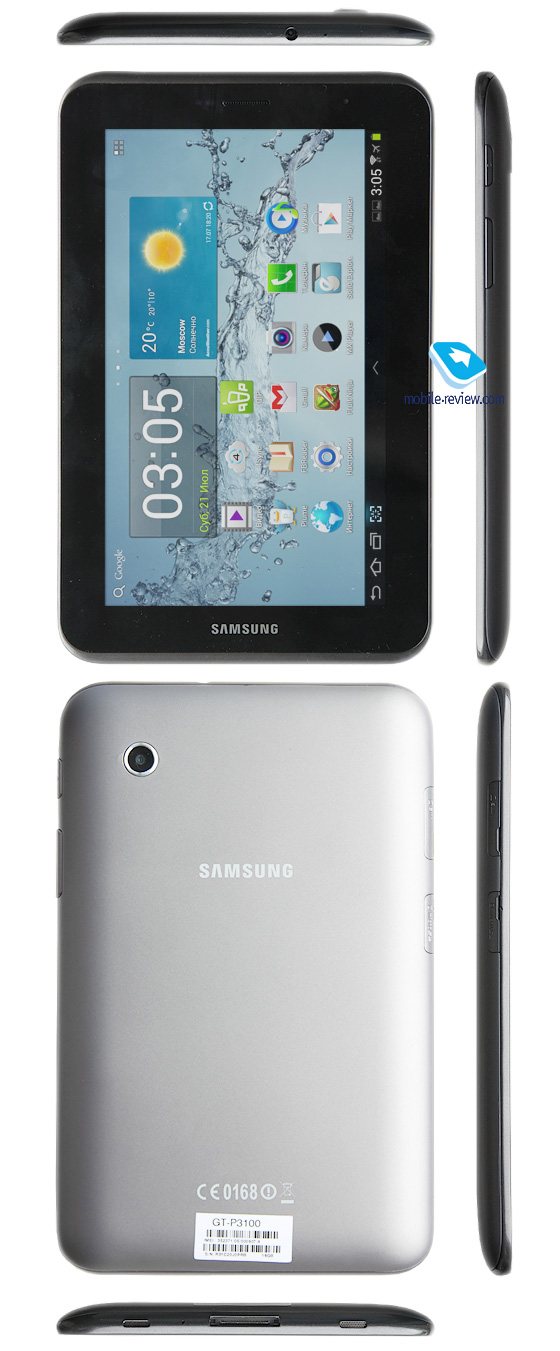
The right side accommodates the volume rocker and the power button. Their travel is short and soft, so the buttons are comfortable to use.

On the left, we get slots for a microSD card and a SIM card (in 3G version). Both slots are covered with protecting caps that are perfectly fastened and don't seem to come loose in the future.

On the bottom, we can see the proprietary charging socket also used to connect the device to a PC. On both sides of it, there are speakers, covered with grids, and a microphone. The sound volume produced by the speakers is moderate, but if you hold the tablet horizontally, you may cover them with your hand.

On the top, we have a 3.5-mm audio jack and another microphone.

The entire front panel is occupied by the screen and a black bezel around it; the front camera eyelet and the voice speaker are above the screen.

The tablet also has a rear side camera. The backside itself is made of grey matt plastic that feels nice to the touch and is quite wear-resistant; no scratches appear on it. So we can be glad Samsung decided not to use their favorite glossy plastic for the backside of this tablet.


By the way, the white version of this model also hit the shelves not so long ago.

There are absolutely no complaints about the build quality, unlike the majority of low-end tablets that normally produce lots of creak and crackle, but we get nothing of the kind here.
Back to the table of contents >>>
Screen
The tablet sports a 7-inch screen with the resolution of 1,024 õ 600 pixels. This capacitive screen supports up to ten touches at a time.

The screen is the PLS type (Samsung's own technology planned to compete with IPS). The specific feature of PLS screens is soft and calm colors, so they are completely on the opposite side of the street with the SuperAMOLED displays. The screen gets faded in the open sunlight, but remains readable though. Traveling on public transport, you will find it comfortable to watch videos, but with the maximum brightness level. The image sharpness is slightly inferior to the IPS competitors. The screen is covered with Gorilla Glass, so if you don't try to leave scratches on it intentionally, you won't see any of them on the glass. I liked the screen: although it is inferior to IPS models, it's still quite good. The minimal brightness is good for reading in the dark, while the maximum level can be suitable for public transport.
The device is equipped with a light sensor responsible for the automatic brightness level adjustment. Not always did it work properly, so I had to use the manual brightness settings. The good thing is that you can adjust the brightness to the desired level in the status bar.
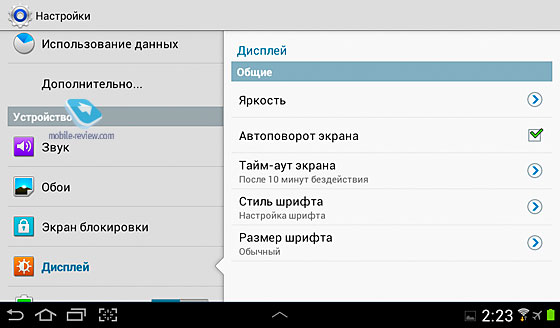
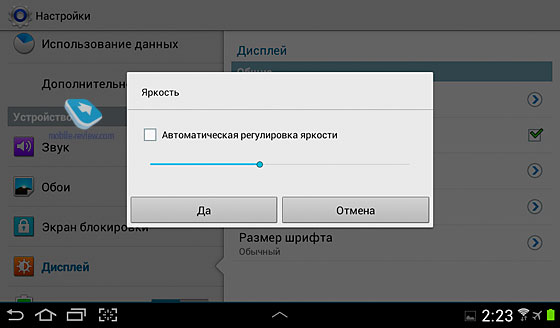
Screen comparison between the Galaxy Tab 2 7.0 and the Digma iDs10:





Back to the table of contents >>>
Dimensions
This tablet is a little thicker than the top Galaxy Tab 7.7 model and the thin IconBIT NetTAB Matrix, and it's a bit heavier, too. But compared to other competitors, its dimensions and weight are quite similar. It's comfortable to hold this tablet both with one or two hands for a long time – your hands won't get exhausted at all. It's also worth mentioning that the device is really compact, so you will be able to put it even into very small bags, which is the common advantage of seven-inch models.
- Samsung Galaxy Tab 2 7.0 – 194 x 122 x 11 mm, 344 g
- Samsung Galaxy Tab 7.7 – 197 x 133 x 8 mm, 335 g
- IconBIT NetTAB Matrix – 188 x 123 x 10 mm, 308 g
- Huawei MediaPad – 190 x 124 x 11 mm, 390 g




Back to the table of contents >>>
Battery
There is a dedicated settings section responsible for power efficiency where you can set a limit for the CPU frequency and adjust the screen for minimized power consumption.

The tablet uses a non-removable 4,000-mAh battery. With an hour of reading and an hour of watching videos at the brightness level of 70% on a daily basis, the battery was enough for 3 days.
I've also made a few battery tests at "net loads":
In the video playback mode, at the maximum brightness and maximum volume in the earphones, the tablet lasted for 4 hours and 45 minutes (MX Player with HW decoding). An HD video file was used for the test.
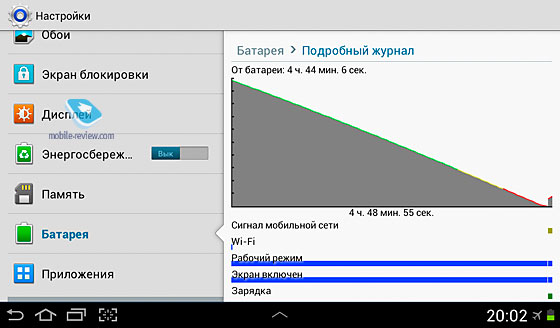
In the reading mode (10% brightness, automatic page scrolling, flight mode on), the battery was enough for 9 hours.
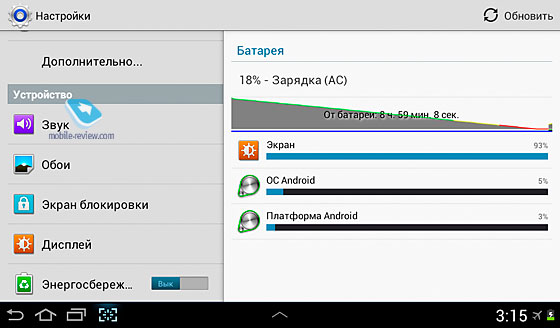
Generally, these are quite good results, so I'm pretty satisfied with the battery.
Back to the table of contents >>>
Performance
Roman has presented a detailed description of the CPU used in the new Samsung tablets, so I will give a quotation from his Tab 2 10.1 review:
"This is where the major changes have been made. Samsung decided not to use the NVIDIA Tegra 2 chipset and installed the OMAP 4430 by Texas Instruments. Technological process – 45 nm, CPU instruction set – ARMv7, graphics accelerator – PowerVR SGX540, dual-core Cortex-A9 CPU running at 1 GHz. This chipset represents the fourth OMAP generation featuring a hardware multimedia accelerator, IVA3, with programmable DSP that enables 1080p Full HD video encode/decode."
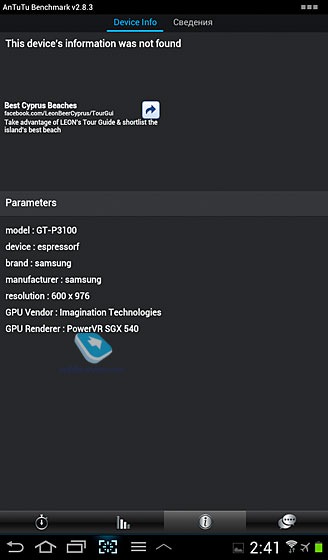
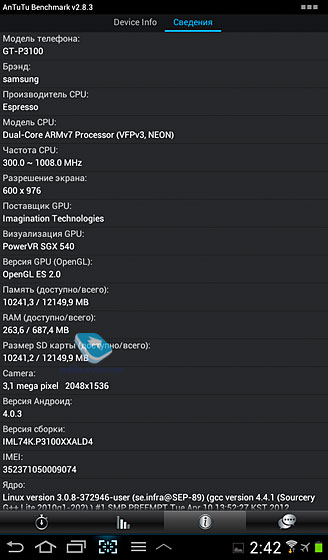
The device has 1 GB of RAM. When turning it on for the first time, there remain about 400 MB available for the user, which is enough for convenient operation with the majority of various tasks. The internal storage may vary: there will be two versions with 8 or 16 GB of ROM.
As for the performance, I have to say this one is faster at web surfing than its competitors. For example, unlike the IconBIT Matrix, using the web browser is really comfortable here. Pages get loaded and scrolled through quickly, so no issues about it.
But when switching between the desktops, some lagging is still observed. But this is a problem caused by the TouchWiz interface shell, and not by the CPU, as you won't experience any lagging if you try any third-party launcher application.
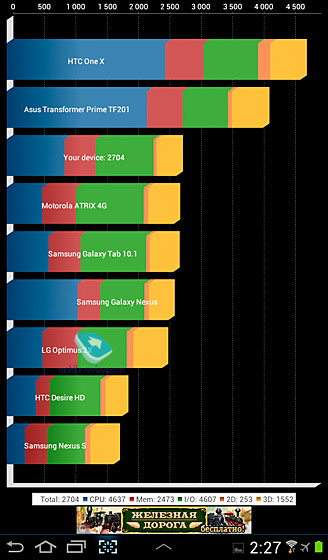
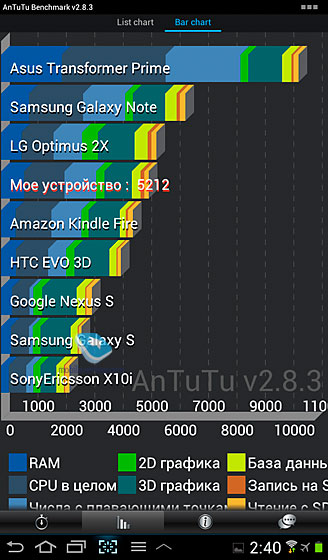
Back to the table of contents >>>
Operating system
The tablet comes with Android 4.0.3 and the TouchWiz shell preinstalled. You can find a detailed review of Android 4.0 here. As for the peculiar features of TouchWiz, I will tell you about them below.
The first thing that becomes obvious at first glance is that the shell is similar to the one installed in the Galaxy S3. For instance, the application menu is designed in the same way and the wallpapers are the same, too.
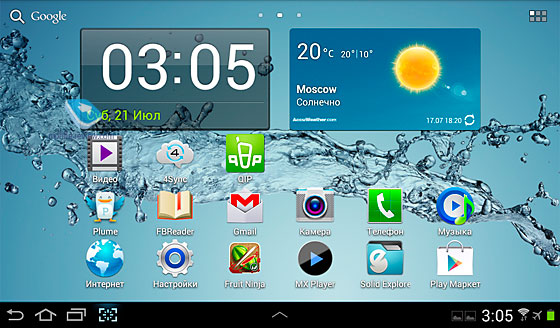
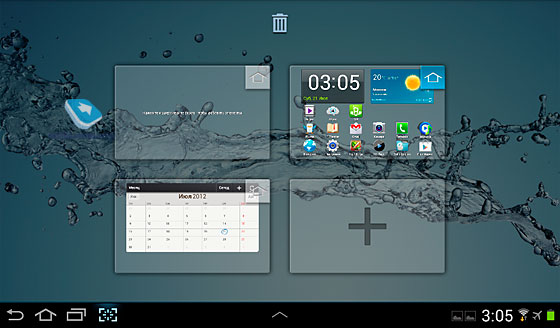
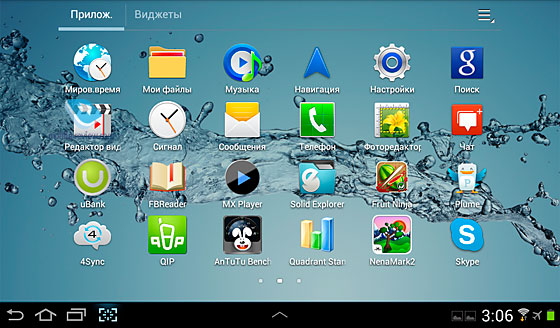
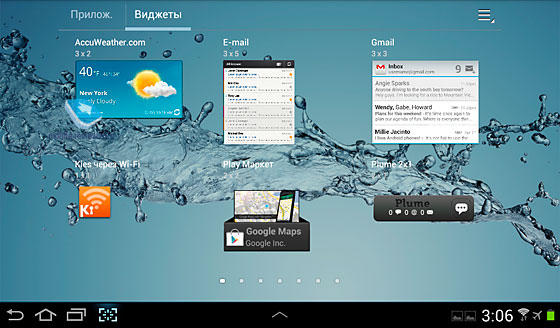

The S Planner and Notes applications are also very much alike the ones in the S3.
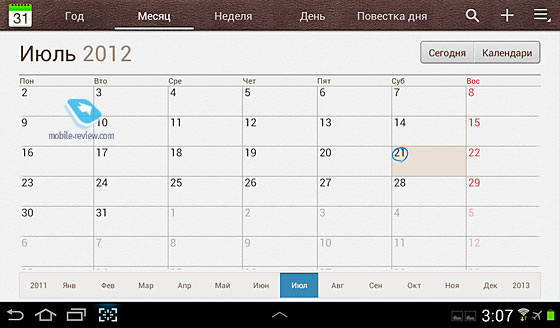
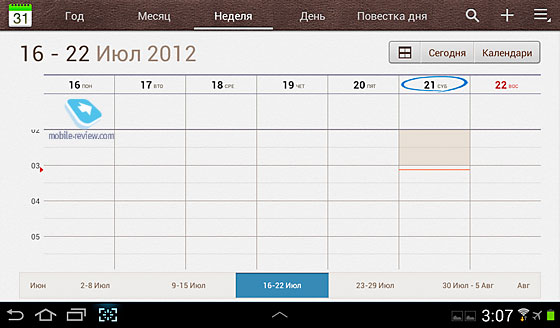
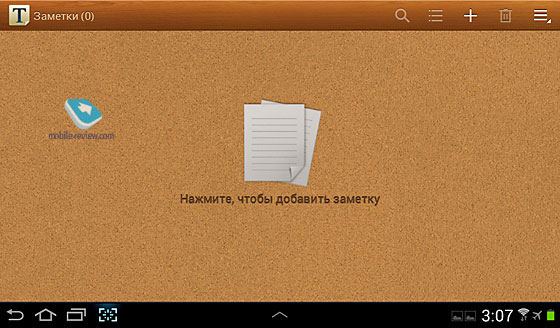
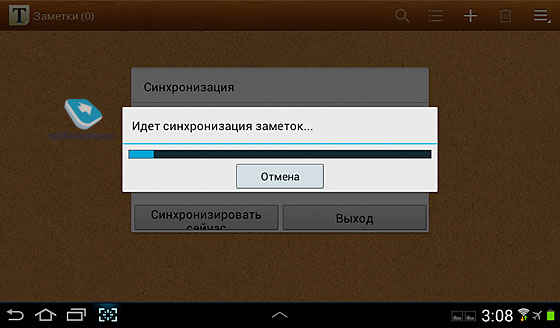
The good thing is that Samsung still offers a preinstalled file manager in their devices. Although it's quite simple, but it will certainly be more than enough for a lot of ordinary users.
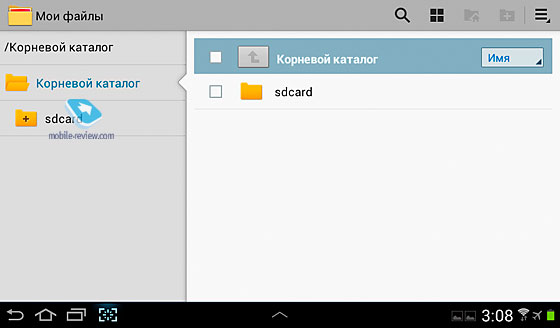
In the new models, they gave up Swype and installed their own keyboard (which looks quite similar to the one in the S3, again). This is a huge step backwards. I liked Swype in the Tab 7.7 very much, but now I can't even install it, as it's not supported anymore. Unlike the keyboard used in the S3, you can't type with gestures here. Of course, the new keyboard is worse than Swype, but still it's quite comfortable, especially in the portrait mode. The separate row of numbers adds some convenience, too.
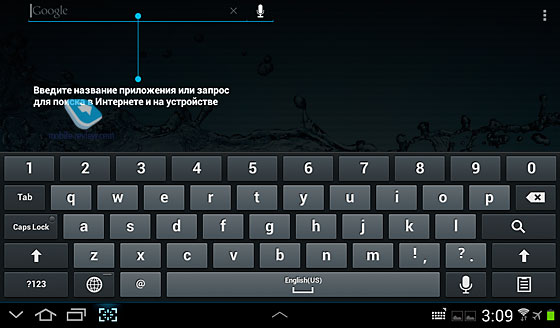
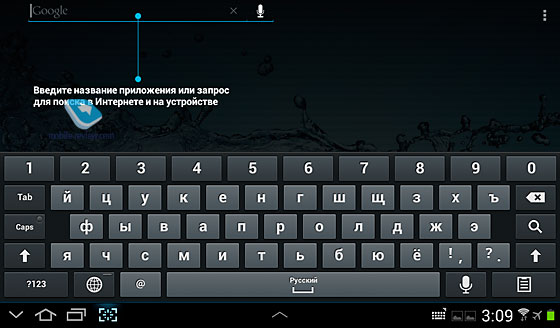
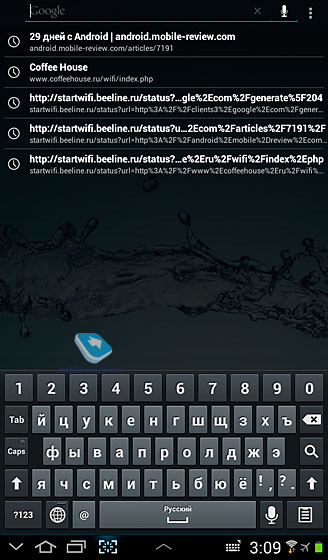
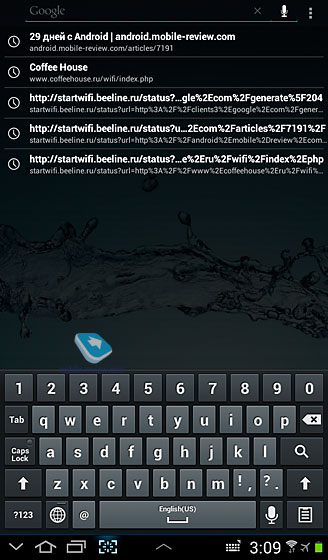
This tablet can work as a regular mobile phone giving you the opportunity to make calls and send text messages. There are special applications preinstalled by the manufacturer. Unfortunately, there are no Cyrillic letters on the dial pad. Besides, the pictures lose their quality after synchronizing. You can't even modify any existing contact in the phone book – you can only add a new one.
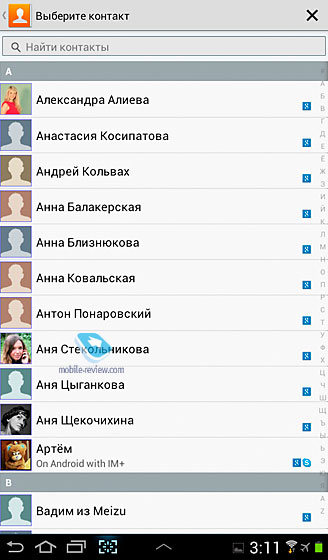
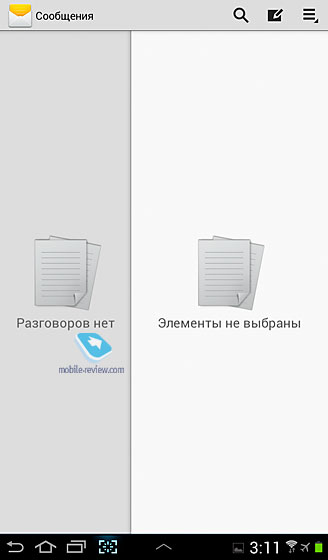
In addition to the three usual buttons, we now have a key for quick screenshots in the status bar. A short tap on the key produces a screenshot and takes you to the editor, while a long tap only produces a screenshot. In the center of the status bar, you find a key to open the panel providing quick access to your most frequent activities. There can be calendar, phone, SMS, email, alarm clock, and music. Tapping on one of the icons shows a miniature of the application. It looks unusual but comfortable.
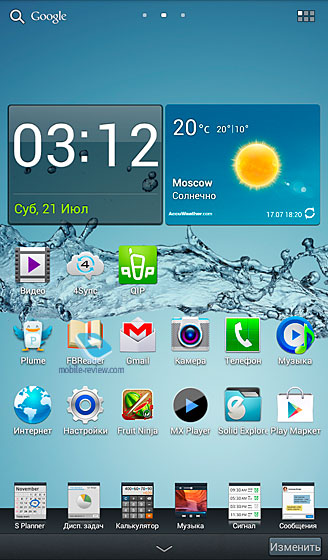

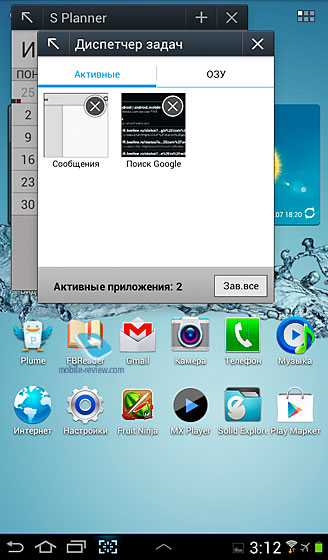
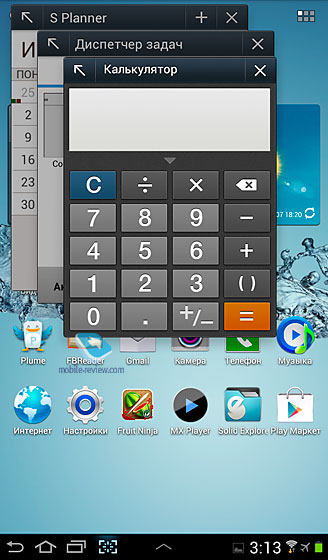
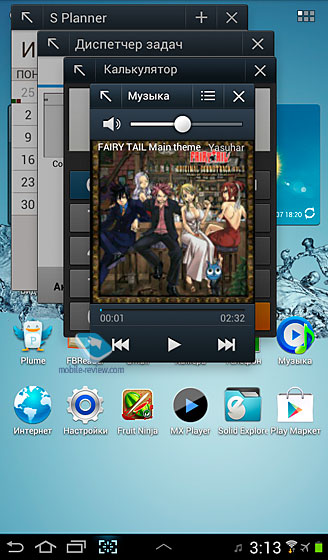

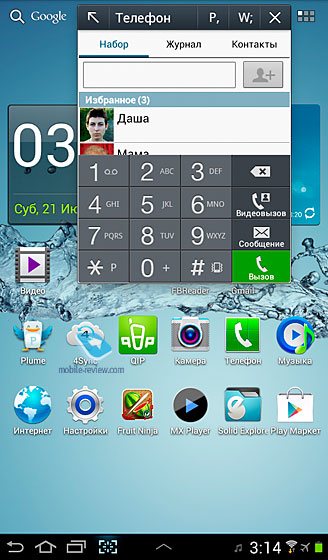
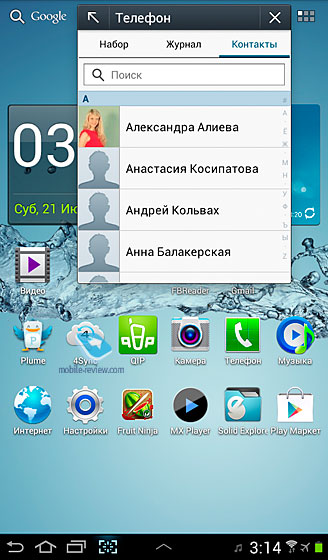
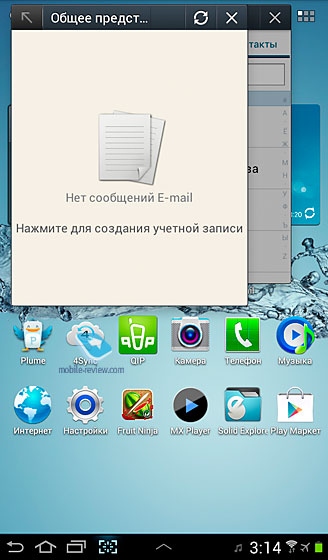
As for the interesting widgets, I'd like to mention the nice-looking clock and the weather widget. By the way, unlike the Galaxy S3, tapping on the clock widget takes you to the alarm clock, but not to the time settings, which is a real convenience.

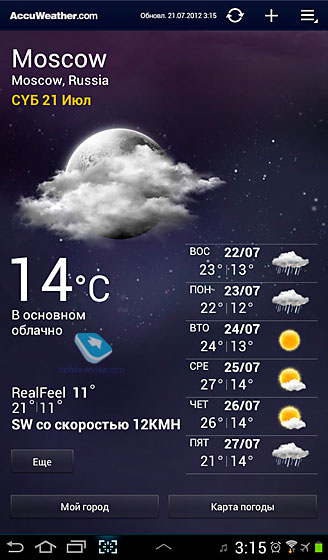
The interface shell makes this model recognizable and different from the competitors. However, Samsung really has to work on it more thoroughly, at least to avoid the desktops lagging.
As for the downsides, I'd like to mention the poor performance of the wallpapers when operating with third-party launcher apps. In any of them (Yandex.Shell, Go Launcher HD for Pad, Apex Launcher, Nova Launcher), the selected wallpapers got bigger and caused the picture to look blurred. And moreover, the lock screen didn't work in the device I tested. I tried to restart the tablet and change its firmware, but nothing helped. Maybe, that was a particular issue with my device.
Back to the table of contents >>>
Multimedia
The Tab 2 7.0 has its own music and video playback applications preinstalled by the manufacturer.
The music player looks very similar in style to that in the Galaxy S3. Opened for the first time, it shows three columns. The first one represents the track sorting options (albums, artists, genres, or folders), in the middle we can see the list of all tracks, and the right column (in landscape mode) or the bottom one (in portrait mode) shows the playback control panel and the list of the tracks in the order they will be played back. The supported audio formats are: MP3, OGG, AAC-LC / AAC / AAC+ / eAAC+, AC-3, AMR-NB / WB, WMA, WAV, MID, IMY, and FLAC. You get a quick access to the playback in the status bar or using a dedicated resizable widget.
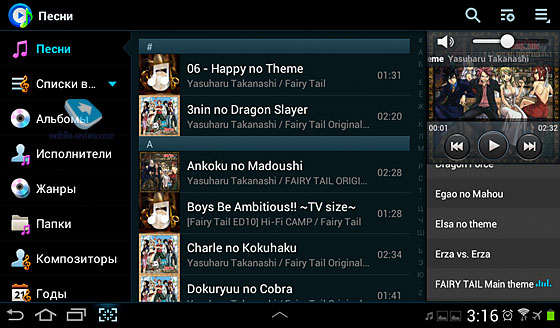
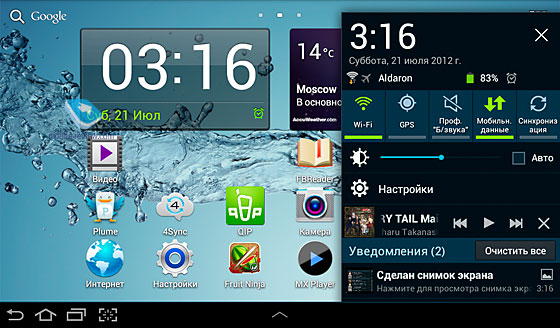

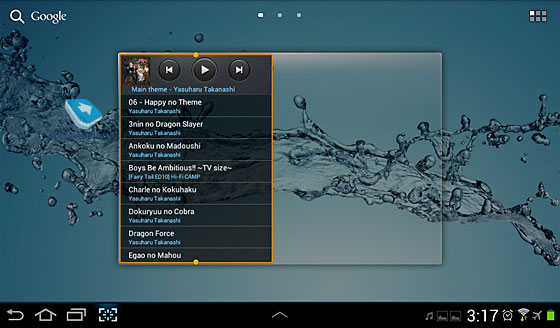
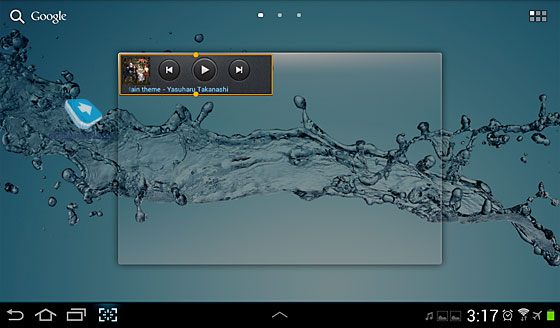
Video. The tablet supports a lot of formats. Since the CPU is the same as used in the bigger model, the results are the same too. So I will quote these results from Roman's Tab 2 10.1 review (I've tested the same video files and got the results as listed below):
- MKV (1080p, h264, High profile 4.1, 40 Ìbps). It didn't work with the default player. Worked with MX Video Player, but with some serious lagging.
- MKV (1080p, vc1, ap13, 18 Ìbps, AC3). The default player was able to play the sound, but not the video. MX Video Player worked with some video lagging and with no sound issues.
- MKV (1080p, h264, High profile 4.1, 10 Ìbps, DTS). The default player played the video, but no sound. MXVP played the video and the sound with no issues, but in the software decoding mode.
- MKV (720p, h264, High profile 5.1, 3 Ìbps). No problems.
- MKV (480p, XViD, as15, 1 Ìbps, AAC). It didn't work with the default player, but worked well with MXVP (software mode).
- MPEG (480p, 5 Ìbps). It didn't work with the default player, but worked perfectly with MXVP.
- TS (720p, MPEG, AC3). It didn't work with the default player, and with MXVP the sound was outrunning the video.
- AVI, MP4, FLV, and 3GP all worked with no issues with the default player.
The default player is rather simple, so I recommend you to replace it with the MX player right away. Judged by the number of supported video formats, the Tab 2 7.0 is slightly inferior to its Chinese competitors, but it's far away ahead of the devices by other eminent manufacturers.

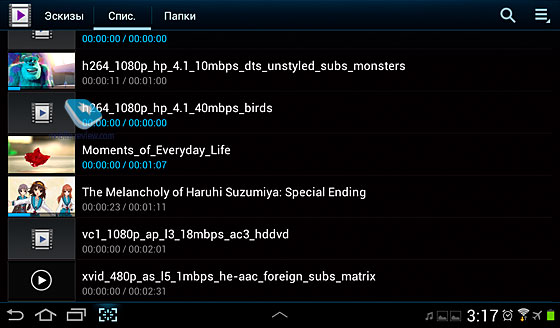
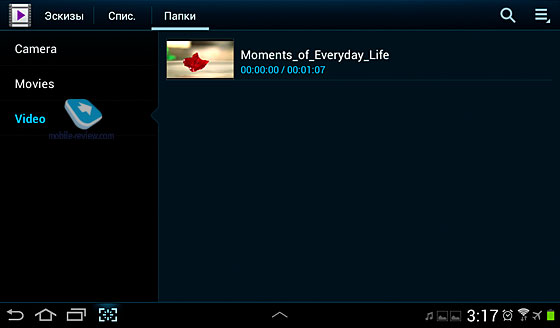
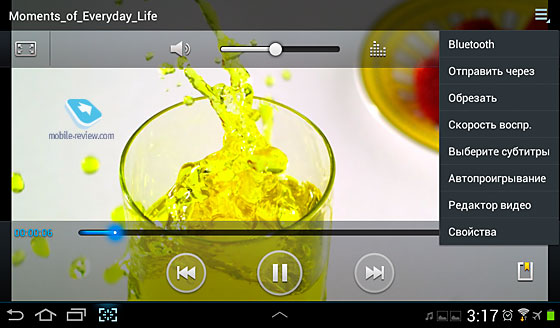
Back to the table of contents >>>
Camera
The tablet has two cameras: the 3-MP camera on the backside and the 0.3-MP front one. Roman has described the camera interface in details, so I recommend you to read this chapter of his review.
The manufacturer decided to leave the main camera without auto focus, which certainly affected the picture quality. You can judge about it yourselves by the samples below.
The camera is able to record 720p videos (1,280 õ 720 pixels) at 30 fps. Besides, the front camera is supported by the Skype application, so you can use it for video calls.
Main camera sample photos::
Front camera sample photos::
Back to the table of contents >>>
Connectivity
The tablet features the full set of wireless connection interfaces.
Wi-Fi (b/g/n): an ordinary Wi-Fi module; no issues about it. It doesn't lose the connection and shows the reception quality similar to the majority of other smartphones and tablets.
3G: optional; works perfectly. Absolutely no issues related to the connection quality.
GPS: Google Maps are used for navigation. The cold start takes about a minute; later, connecting to the satellites takes 20 to 30 seconds.
Bluetooth 4.0: the latest version is characterized through lower power consumption.
Back to the table of contents >>>
Conclusion
The average price of the Wi-Fi version is $290; the 3G one costs $400. Paying as much as that, you get a full-blown tablet (although a small one) that is perfectly capable of video playback, web surfing and reading. Besides, you can even make phone calls with it. And the good build quality and materials are also its advantages.
Back to the table of contents >>>
Competitors
There are a few competitors for the Wi-Fi version.
IconBIT MATRIX. A fairly good model; an absolute clone of the Ainol Aurora. Its advantages are a better screen and lower weight and thickness. The downsides are poor web browser operation and the awful build quality. It costs about $185. Now the NetTAB Slim Pro is coming to replace it, and I'm only planning to take it for a test. If it doesn't have those problems with the web browser and build quality, then it is going to be a serious competitor, for its price is only $185.

Samsung Galaxy Tab 7.0 Plus. An identical model by Samsung, but with a different CPU. Not long ago, they started to update it to Android 4.0. Its price is a bit higher, so I'd rather look at the Tab 2 7.0.
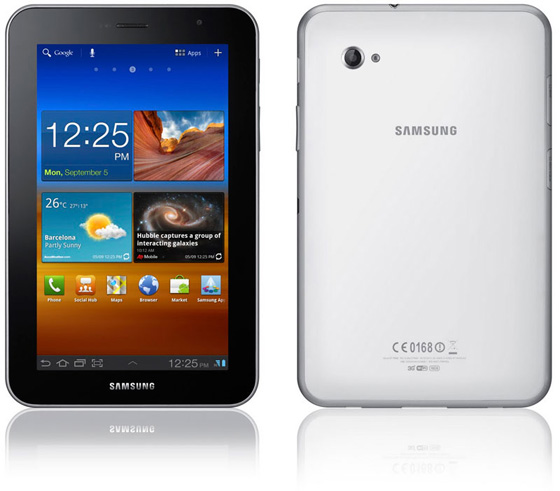
The 3G version has a more serious competitor – the Huawei MediaPad. Its average price is $400. Its huge advantage is its screen and the "pure" Android, as well as the monolithic aluminum body. The only advantages of the Tab 2 7.0 are the opportunity to make phone calls and the more eminent manufacturer.
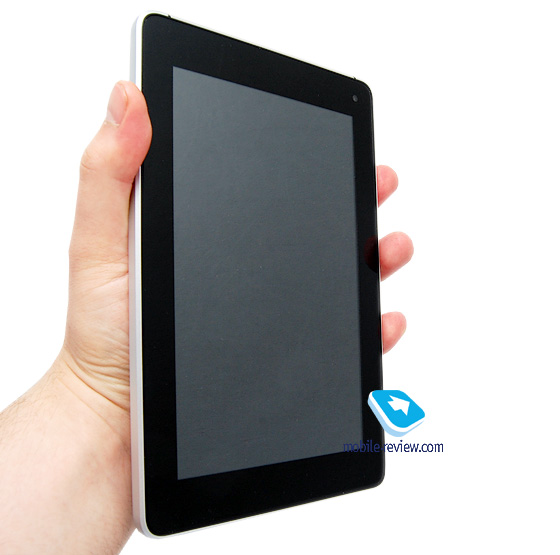
As a result, if you need a high-quality 7-inch tablet with 3G connectivity, you'd better pay attention to the Huawei MediaPad; if you are trying to spend less money and have Wi-Fi only, the Tab 2 7.0 is a pretty good deal, as the price difference of about $60, if compared to the iconBIT models and other tablets by not so well-known manufacturers, seems quite reasonable.

Advantages:
- Good screen
- Fast web browser
- Good-looking widgets
- Preinstalled audio and video players
- Support for a lot of audio and video formats
- High build quality
Disadvatanges:
- Price
- Proprietary charging and PC synchronizing socket
- TouchWiz lags
- No auto focus for the camera
Do you want to talk about this? Please, go to our Forum and let your opinion be known to the author and everybody else.
Back to the table of contents >>>
Evgeny Vildyaev ([email protected])
 Twitter Twitter
Translated by Serge Gomelsky ([email protected])
Published — 31 July 2012
Have something to add?! Write us... [email protected]
|



















































































